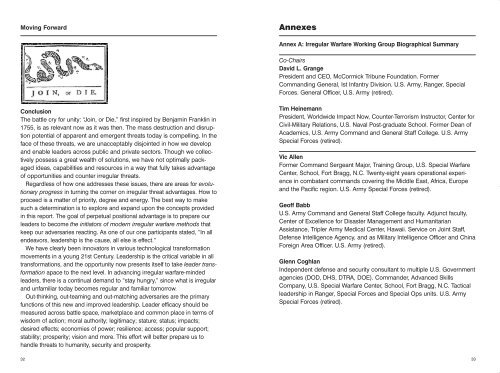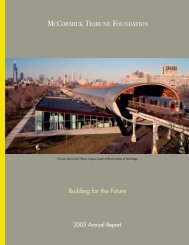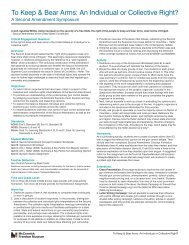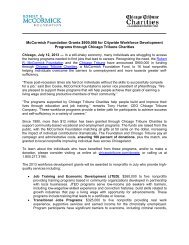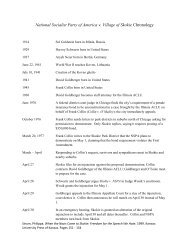Irregular Warfare Leadership in the 21st Century
Irregular Warfare Leadership in the 21st Century
Irregular Warfare Leadership in the 21st Century
You also want an ePaper? Increase the reach of your titles
YUMPU automatically turns print PDFs into web optimized ePapers that Google loves.
Mov<strong>in</strong>g Forward<br />
Annexes<br />
Annex A: <strong>Irregular</strong> <strong>Warfare</strong> Work<strong>in</strong>g Group Biographical Summary<br />
Co-Chairs<br />
David L. Grange<br />
President and CEO, McCormick Tribune Foundation. Former<br />
Command<strong>in</strong>g General, Ist Infantry Division. U.S. Army, Ranger, Special<br />
Forces. General Officer, U.S. Army (retired).<br />
Conclusion<br />
The battle cry for unity: “Jo<strong>in</strong>, or Die,” first <strong>in</strong>spired by Benjam<strong>in</strong> Frankl<strong>in</strong> <strong>in</strong><br />
1755, is as relevant now as it was <strong>the</strong>n. The mass destruction and disruption<br />
potential of apparent and emergent threats today is compell<strong>in</strong>g. In <strong>the</strong><br />
face of <strong>the</strong>se threats, we are unacceptably disjo<strong>in</strong>ted <strong>in</strong> how we develop<br />
and enable leaders across public and private sectors. Though we collectively<br />
possess a great wealth of solutions, we have not optimally packaged<br />
ideas, capabilities and resources <strong>in</strong> a way that fully takes advantage<br />
of opportunities and counter irregular threats.<br />
Regardless of how one addresses <strong>the</strong>se issues, <strong>the</strong>re are areas for evolutionary<br />
progress <strong>in</strong> turn<strong>in</strong>g <strong>the</strong> corner on irregular threat advantages. How to<br />
proceed is a matter of priority, degree and energy. The best way to make<br />
such a determ<strong>in</strong>ation is to explore and expand upon <strong>the</strong> concepts provided<br />
<strong>in</strong> this report. The goal of perpetual positional advantage is to prepare our<br />
leaders to become <strong>the</strong> <strong>in</strong>itiators of modern irregular warfare methods that<br />
keep our adversaries react<strong>in</strong>g. As one of our one participants stated, “In all<br />
endeavors, leadership is <strong>the</strong> cause, all else is effect.”<br />
We have clearly been <strong>in</strong>novators <strong>in</strong> various technological transformation<br />
movements <strong>in</strong> a young <strong>21st</strong> <strong>Century</strong>. <strong>Leadership</strong> is <strong>the</strong> critical variable <strong>in</strong> all<br />
transformations, and <strong>the</strong> opportunity now presents itself to take leader transformation<br />
apace to <strong>the</strong> next level. In advanc<strong>in</strong>g irregular warfare-m<strong>in</strong>ded<br />
leaders, <strong>the</strong>re is a cont<strong>in</strong>ual demand to “stay hungry,” s<strong>in</strong>ce what is irregular<br />
and unfamiliar today becomes regular and familiar tomorrow.<br />
Out-th<strong>in</strong>k<strong>in</strong>g, out-team<strong>in</strong>g and out-match<strong>in</strong>g adversaries are <strong>the</strong> primary<br />
functions of this new and improved leadership. Leader efficacy should be<br />
measured across battle space, marketplace and common place <strong>in</strong> terms of<br />
wisdom of action; moral authority; legitimacy; stature; status; impacts;<br />
desired effects; economies of power; resilience; access; popular support;<br />
stability; prosperity; vision and more. This effort will better prepare us to<br />
handle threats to humanity, security and prosperity.<br />
Tim He<strong>in</strong>emann<br />
President, Worldwide Impact Now, Counter-Terrorism Instructor, Center for<br />
Civil-Military Relations, U.S. Naval Post-graduate School. Former Dean of<br />
Academics, U.S. Army Command and General Staff College. U.S. Army<br />
Special Forces (retired).<br />
Vic Allen<br />
Former Command Sergeant Major, Tra<strong>in</strong><strong>in</strong>g Group, U.S. Special <strong>Warfare</strong><br />
Center, School, Fort Bragg, N.C. Twenty-eight years operational experience<br />
<strong>in</strong> combatant commands cover<strong>in</strong>g <strong>the</strong> Middle East, Africa, Europe<br />
and <strong>the</strong> Pacific region. U.S. Army Special Forces (retired).<br />
Geoff Babb<br />
U.S. Army Command and General Staff College faculty. Adjunct faculty,<br />
Center of Excellence for Disaster Management and Humanitarian<br />
Assistance, Tripler Army Medical Center, Hawaii. Service on Jo<strong>in</strong>t Staff,<br />
Defense Intelligence Agency, and as Military Intelligence Officer and Ch<strong>in</strong>a<br />
Foreign Area Officer. U.S. Army (retired).<br />
Glenn Coghlan<br />
Independent defense and security consultant to multiple U.S. Government<br />
agencies (DOD, DHS, DTRA, DOE). Commander, Advanced Skills<br />
Company, U.S. Special <strong>Warfare</strong> Center, School, Fort Bragg, N.C. Tactical<br />
leadership <strong>in</strong> Ranger, Special Forces and Special Ops units. U.S. Army<br />
Special Forces (retired).<br />
32 33


